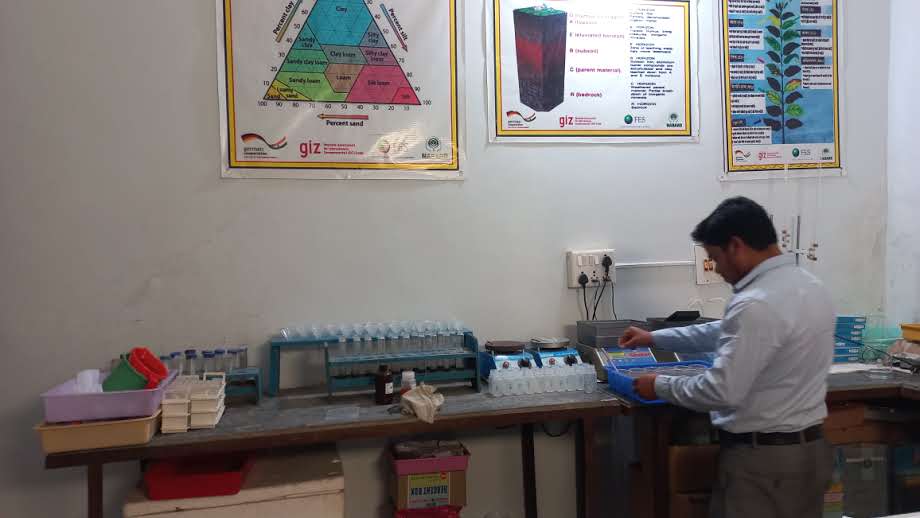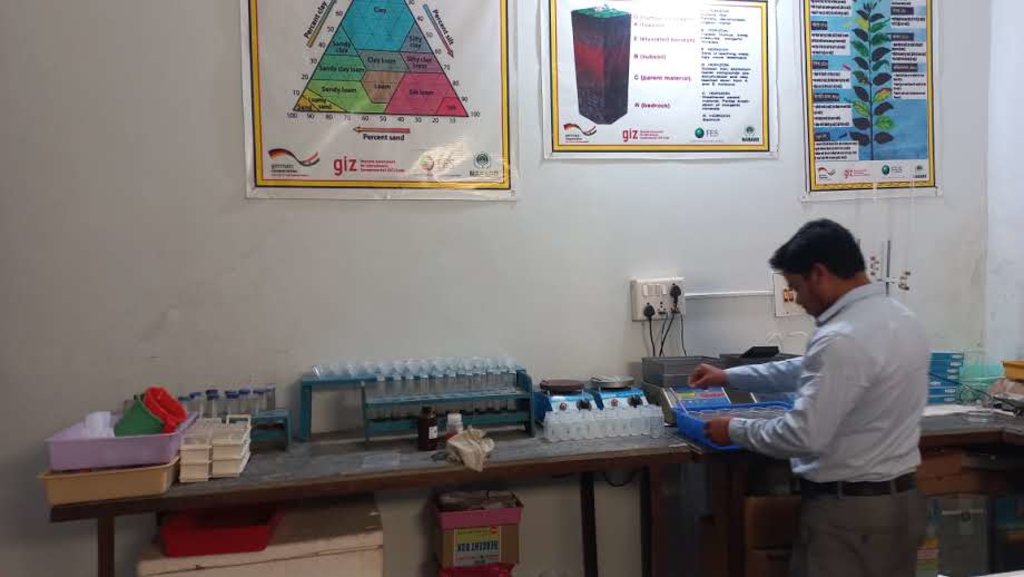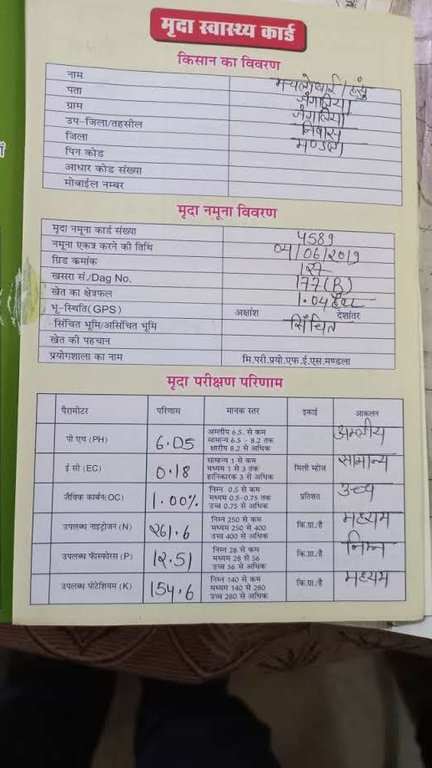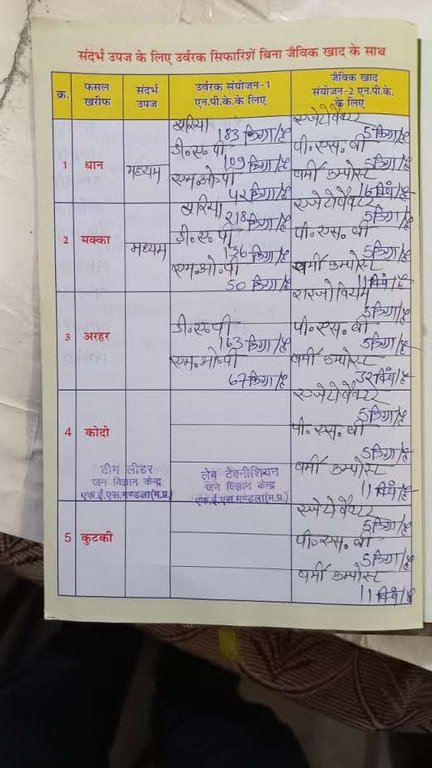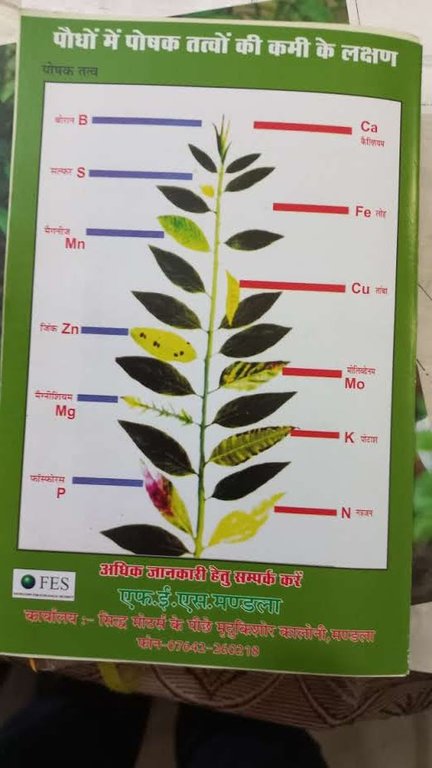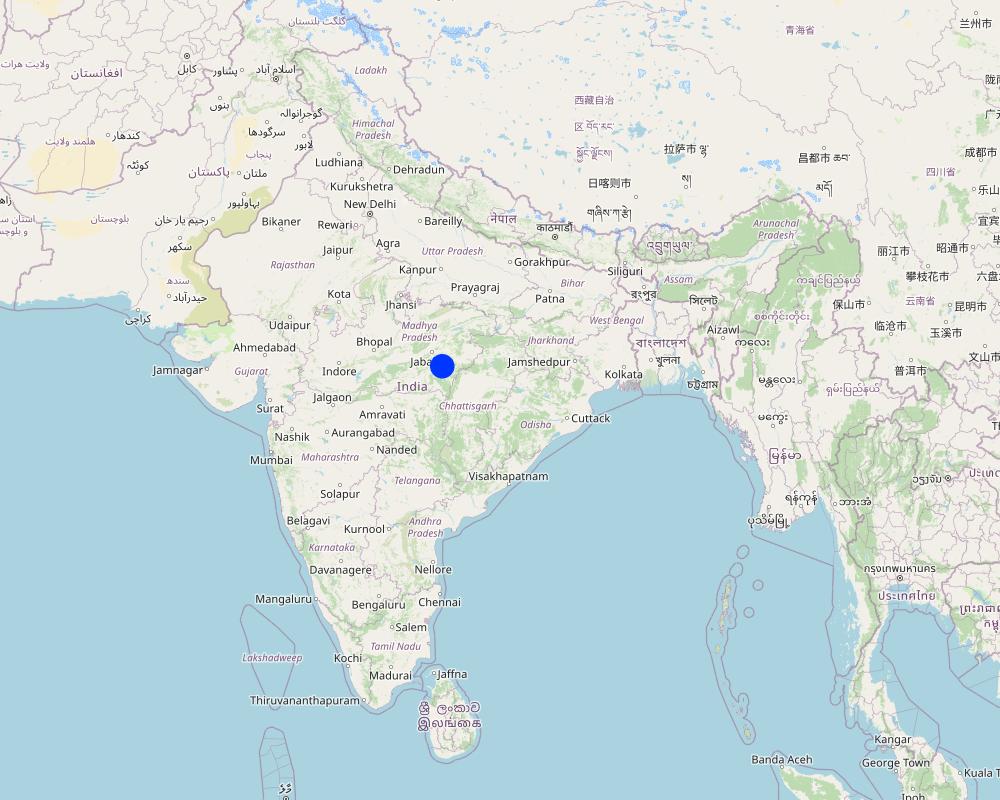Dissemination of Soil Test Results to Farmers through a Participatory Approach [อินเดีย]
- ผู้สร้างสรรค์:
- การอัพเดท:
- ผู้รวบรวม: Santosh Gupta
- ผู้เรียบเรียง: Noel Templer, Stephanie Katsir, Tabitha Nekesa, Ahmadou Gaye, Siagbé Golli
- ผู้ตรวจสอบ: Udo Höggel, Joana Eichenberger, Sally Bunning
Mitti ki namuna
approaches_6698 - อินเดีย
- บทสรุปทั้งหมดในรูปแบบของ PDF
- บทสรุปทั้งหมดในรูปแบบของ PDF เพื่อพิมพ์
- บทสรุปทั้งหมดในรูปหน้าเว็บ
- บทสรุปทั้งหมด (ไม่มีการจัดเรียง)
- Dissemination of Soil Test Results to Farmers through a Participatory Approach: 18 มิถุนายน 2023 (inactive)
- Dissemination of Soil Test Results to Farmers through a Participatory Approach: 14 กันยายน 2023 (inactive)
- Dissemination of Soil Test Results to Farmers through a Participatory Approach: 11 เมษายน 2024 (public)
ดูส่วนย่อย
ขยายทั้งหมด ย่อทั้งหมด1. ข้อมูลทั่วไป
1.2 รายละเอียดที่ติดต่อได้ของผู้รวบรวมและองค์กรที่เกี่ยวข้องในการประเมินและการจัดเตรียมทำเอกสารของแนวทาง
ชื่อของโครงการซึ่งอำนวยความสะดวกในการทำเอกสารหรือการประเมินแนวทาง (ถ้าเกี่ยวข้อง)
Soil protection and rehabilitation for food security (ProSo(i)l)ชื่อของโครงการซึ่งอำนวยความสะดวกในการทำเอกสารหรือการประเมินแนวทาง (ถ้าเกี่ยวข้อง)
Deutsche Gesellschaft für Internationale Zusammenarbeit (GIZ)ชื่อของโครงการซึ่งอำนวยความสะดวกในการทำเอกสารหรือการประเมินแนวทาง (ถ้าเกี่ยวข้อง)
CIAT International Center for Tropical Agriculture (CIAT International Center for Tropical Agriculture) - เคนยาชื่อของโครงการซึ่งอำนวยความสะดวกในการทำเอกสารหรือการประเมินแนวทาง (ถ้าเกี่ยวข้อง)
Ecociate Consultants (Ecociate Consultants) - อินเดีย1.3 เงื่อนไขที่เกี่ยวข้องกับการใช้ข้อมูลที่ได้บันทึกไว้ผ่านทาง WOCAT
วันที่เก็บรวบรวมข้อมูล (ภาคสนาม):
22/02/2023
ผู้รวบรวมและวิทยากรหลักยอมรับเงื่อนไขเกี่ยวกับการใช้ข้อมูลที่ถูกบันทึกผ่านทาง WOCAT:
ใช่
2. คำอธิบายของแนวทาง SLM
2.1 การอธิบายแบบสั้น ๆ ของแนวทาง
A systematic approach has been developed under the project for collecting soil samples, conducting the soil test results, issuing soil health cards, building the capacity of farmers to interpret the soil health card and apply the required nutrients to the soil based on the soil test result
2.2 การอธิบายอย่างละเอียดของแนวทาง
การอธิบายอย่างละเอียดของแนวทาง:
Soil testing is a pre-cultivation activity that gives a good idea about soil structure and mineral composition ratios. The essential nutrients required for various crop growths can be estimated during soil testing. The Foundation for Ecological Security (FES) has established a state-of-the-art soil testing laboratory for testing soil samples in India's Mandla District of Madhya Pradesh. The soil test lab was established in 2016 with a capacity to test 1500-2000 soil samples every year. Based on a soil sampling process, it takes around 2 days to generate the soil test results for 20 soil samples. Collected soil samples are tested for 12 parameters. These parameters include Soil Ph, Soil organic carbon (SoC), electrical conductivity (EC), major nutrients like nitrogen(N), phosphorus (P), potassium (K), secondary nutrients like sulphur, magnesium, iron, boron, zinc, manganese, and copper. Based on the soil test report, farmers are issued a soil health card with crop-specific recommendations for additional chemical and organic inputs into the soil.
To ensure the accuracy of the sampling process and proper dissemination of generated results among the farmers, FES has developed a very systematic process which consists of:
•the collection of soil samples
•the analysis of collected soil samples in an FES lab
•the issuance of soil health cards
•the interpretation of soil test results
•noticing of test results to farmers
•farmers are able to implement practices, recommended by the test result
The entire process, from soil sampling to dissemination, is briefly mentioned below:
•Developing the grids for a random collection of soil samples: The first step is to develop a geographical grid for collecting random samples based on predefined parameters. In the irrigated areas, samples are drawn in a grid of 2.5 ha, while in rainfed areas, samples are drawn from a grid of 10 ha. While developing the grid, farmers' fields are categorized into the following parameters. Each of the parameters is assigned a specific score, and based on the obtained score, each farmer’s land is given a specific number for easy identification on soil maps. These include the a) type of soil, b) type of field, e.g., upland, medium land, or low land, c) crop cycle (Single crop, multiple crops) d) The slope of the field. This entire exercise is a soil survey exercise used to develop soil maps for each geographical unit village, block, district.
•Collection of soil samples: From each classified grid, soil samples are collected from 5 different locations between the harvest of one crop and the sowing/planting of another crop when fields are vacant. The soil samples are collected at a depth of 5 to 15 cm. All the collected soil samples are mixed repeatedly, and a portion of the collected soil is kept aside each time. The mixing process is followed 5-6 times to ensure collected soil samples represent the entire area. Finally, around 500 gm of soil is packed in plastic polythene based on the above grid parameters.
•Soil sample analysis: Collected soil samples are transported to the centralized soil test lab in Mandla (MP) for testing and analysis. The samples are analyzed by qualified lab personnel. The analysis process for the above mentioned 12 parameters takes around 2 days (considering 8-9 working hours in a day).
•Issuance of soil health card: Based on the results obtained from the analysis, soil health cards are issued to farmers. The soil health card contains the following information in the local language (Hindi) so that farmers understand the test results and their implications:
a.Basic details of the farmer: name, address, soil grid, GPS coordinates, field identification number, etc.
b.Soil test results for above mentioned 12 parameters: results of the soil test in their respective units, standard numbers, grading of the obtained result (acidic/saline for PH., high, medium, low for other parameters)
c.Crop-wise soil correction recommendations for major crops: recommendations for synthetic fertilizers, biofertilizers, and compost
d.Pre-printed information with photos for identification of nutrient deficiency in the crops.
•Dissemination of soil health card to farmers: To ensure that farmers understand the results and implement the practices at their field, local community resource persons reach out to every farmer to make them understand the soil test results and closely monitor their farmers’ practices across the crop stages. Farmers are also encouraged to maintain farm diaries for their practices. They are also trained in the preparation of various bio-inputs and compost for application in their field.
2.3 รูปภาพของแนวทาง
ข้อสังเกตทั่วไปเกี่ยวกับรูปภาพ:
All the photos have been taken at the soil test lab of the FES.
2.5 ประเทศ ภูมิภาค หรือสถานที่ตั้งที่ได้นำแนวทางไปใช้
ประเทศ:
อินเดีย
ภูมิภาค/รัฐ/จังหวัด: :
Madhya Pradesh
ข้อมูลเฉพาะเพิ่มเติมของสถานที่ตั้ง:
Mandla
ความคิดเห็น:
Mandla, Madhya Pradesh, India
Map
×2.6 วันที่เริ่มต้นและสิ้นสุดของแนวทาง
ระบุปีที่เริ่ม:
2018
2.7 ประเภทของแนวทาง
- ใช้โครงงานหรือแผนงานเป็นฐาน
2.8 เป้าหมายหรือวัตถุประสงค์หลักของแนวทาง
1. Ensure judicious usage of fertilizers and micronutrients based on the requirement of the soil
2. Ensure quality soil testing and dissemination of results
3. Build farmers' capacity for interpretation of soil health cards
4. Develop soil maps based on the in-house results from the soil test lab
2.9 เงื่อนไขที่เอื้ออำนวยหรือเป็นอุปสรรคต่อการนำเทคโนโลยีภายใต้แนวทางนี้ไปปฏิบัติใช้
การจัดตั้งระดับองค์กร
- เอื้ออำนวย
The entire dissemination methodology is done through community-based organizations
การร่วมมือหรือการทำงานประสานกันของผู้ลงมือปฏิบัติ
- เอื้ออำนวย
Several stakeholders, such as FES, farmers, equipment suppliers, the scientific community, and soil scientists, are involved in the project
นโยบาย
- เอื้ออำนวย
Soil test results are an excellent input for the agricultural policies around fertilizers, farming practices, and soil health-related policies
การกำกับดูแลที่ดิน (การตัดสินใจ การนำเอาไปปฏิบัติใช้ และการบังคับใช้)
- เอื้ออำนวย
A soil health card is an excellent tool for farmers to decide on the usage of fertilizers and the kind of farming practices to implement
ความรู้เกี่ยวกับ SLM การเข้าถึงการสนับสนุนด้านเทคนิค
- เอื้ออำนวย
Soil health cards inform the farmers and the project management team so to decide on required interventions and farming practices
ตลาด (จัดซื้อปัจจัยนำเข้า ขายผลิตภัณฑ์) และราคา
- เอื้ออำนวย
Very much relevant as soil test results quantify the number of farm inputs to be applied to the farm
3. การมีส่วนร่วมและบทบาทของผู้มีส่วนได้ส่วนเสียที่เกี่ยวข้อง
3.1 ผู้มีส่วนได้ส่วนเสียที่เกี่ยวข้องในแนวทางนี้และบทบาท
- ผู้ใช้ที่ดินระดับท้องถิ่นหรือชุมชนระดับท้องถิ่น
Farmers from the project area
Soil samples were collected from the field of farmers. They have actively participated in the projects for managing the soil samples, participating in the capacity building programs, and implementing the recommended practices.
- องค์กรที่ขึ้นอยู่กับชุมชน
FES, the implementing NGO, have formed the Villages Environment Committee (VEC) in their project villages as community-based organizations
VECs facilitated the implanting of a project by mobilizing the communities as and when needed. FES reached farmers through the VECs, to collect the soil samples or disseminate the information. VECs also facilitated community-level implementation activities.
- ผู้เชี่ยวชาญ SLM หรือที่ปรึกษาการเกษตร
SLM Specialist
Documentation of the activities
- องค์กรพัฒนาเอกชน
Foundation for Ecological Security (FES) is a well-known NGO registered in India. It focuses on ecology-related issues and works closely with farmers and forest-based communities.
FES played an essential role in the project. Primary activities were as follows:
1. Establishment of soil testing laboratory and hiring the technical team to conduct the soil test lab
2. Collection of soil test samples and building the capacity of farmers on soil sample collection
3. Conducting soil test results and issuance of soil health cards to farmers
4. Developing a soil health map for the project areas
5. Capacity building of farmers for the interpretation of soil health cards and ensuring the implementation of recommended practices
- องค์การระหว่างประเทศ
GIZ, India
Funding of the project
ถ้ามีผู้มีส่วนได้ส่วนเสียหลายคนที่เกี่ยวข้องให้ระบุหน่วยงานตัวแทน:
Foundation for Ecological Security
3.2 การเกี่ยวข้องของผู้ใช้ที่ดินระดับท้องถิ่นหรือชุมชนระดับท้องถิ่นในช่วงต่างๆของแนวทาง
| ความเกี่ยวข้องของผู้ใช้ที่ดินระดับท้องถิ่นหรือชุมชนระดับท้องถิ่น | ระบุผู้ที่มีส่วนเกี่ยวข้องและอธิบายกิจกรรม | |
|---|---|---|
| การริเริ่มหรือการจูงใจ | ไม่ลงมือ | The FES led the initiation of discussions with its donor organizations. Discussions with communities to understand the challenges and opportunities. |
| การวางแผน | ปฏิสัมพันธ์ | Local community institutions played a significant role in the entire process of planning and execution |
| การดำเนินการ | ปฏิสัมพันธ์ | Farmers and community-based institutions were actively involved in implementing multiple activities under the project, such as collecting soil samples, supplying them to the soil test labs, and Implementing the recommended practices. |
| การติดตามตรวจสอบหรือการประเมินผล | ปฏิสัมพันธ์ | Community-based institutions played an important role in monitoring individual farmers for implementing the recommendations provided to farmers. They also monitored the results regarding crop progress, crop productivity, and improvement in soil health status. |
3.4 การตัดสินใจเลือกใช้เทคโนโลยี SLM
ระบุผู้ที่ทำการตัดสินใจเลือกเทคโนโลยีมากกว่าหนึ่งวิธีไปปฏิบัติใช้:
- ผู้ลงมือปฏิบัติที่เกี่ยวข้องทั้งหมดในฐานะที่เป็นส่วนรวมของแนวทาง
การอธิบาย:
All actors, including the farmers, CBO, NGO, and soil scientists, mutually discussed and decided on the implementation of technology as all stakeholders were equally crucial for the effective and result-oriented implementation of the technology.
ระบุว่าการตัดสินใจตั้งอยู่บนพื้นฐานของ:
- การประเมินความรู้ SLM ที่ได้ทำการบันทึกไว้เป็นอย่างดี (การใช้ข้อมูลในการตัดสินใจ)
- สิ่งที่ค้นพบจากงานวิจัย
4. การสนับสนุนด้านเทคนิค การสร้างขีดความสามารถ และการจัดการด้านความรู้
4.1 การสร้างขีดความสามารถ / การอบรม
ได้มีการจัดอบรมให้แก่ผู้ใช้ที่ดินหรือผู้มีส่วนได้ส่วนเสียคนอื่น ๆ หรือไม่:
ใช่
ให้ระบุว่าใครเป็นผู้ได้รับการอบรม:
- ผู้ใช้ที่ดิน
- เจ้าหน้าที่ภาคสนาม / ที่ปรึกษา
ถ้าเกี่ยวข้อง ให้ระบุ เพศ อายุ สถานภาพ ชาติพันธุ์ เป็นต้น:
Both male and female farmers in all age groups were trained under the project. The majority of the farmers were from tribal communities.
รูปแบบการอบรม:
- เกษตรกรกับเกษตรกร
- ใช้พื้นที่ทำการสาธิต
- จัดการประชุมสู่สาธารณชน
หัวข้อที่พูด:
1. Importance of soil testing for the judicious use of fertilizers
2. Methods for soil sample collection
3. Interpretation of soil health card
4. Dissemination of soil test results and ways and means for implementing the recommended practices following organic and non-organic implementation practices
4.2 การบริการให้คำแนะนำ
ผู้ใช้ที่ดินมีการเข้าถึงการรับบริการให้คำปรึกษาหรือไม่:
ใช่
ระบุว่ามีบริการให้คำปรึกษาหรือไม่:
- ไปเยี่ยมชมสถานที่
การอธิบาย/แสดงความคิดเห็น:
FES has a team of community-based resource persons from the local community and villages to provide advisory services to farmers
4.3 การเสริมความแข็งแกร่งให้กับสถาบัน (การพัฒนาองค์กร)
สถาบันได้รับการจัดตั้งขึ้นมาหรือเสริมความแข็งแกร่งโดยแนวทางนี้หรือไม่:
- ใช่ อย่างมาก
ระบุระดับของสถาบันที่ได้รับการเสริมความแข็งแกร่งหรือจัดตั้งขึ้นมา:
- ท้องถิ่น
อธิบายถึงสถาบัน บทบาทและความรับผิดชอบ สมาชิก เป็นต้น:
Village-level environment committees were formed to discuss the issues related to environmental concerns, livelihoods, and other social problems at the village level. These committees consist of male and female members representing the entire village.
ระบุประเภทของการให้ความช่วยเหลือสนับสนุน:
- ด้านการเงิน
- การสร้างขีดความสามารถ / การอบรม
ให้รายละเอียดเพิ่มเติม :
These committees were provided financial support to implement the identified activities based on the provision under the project and proposals submitted by the local committees. FES regularly provides training and handholding support to these committees.
4.4 การติดตามตรวจสอบและประเมินผล
การติดตามตรวจสอบและประเมินผลเป็นส่วนหนึ่งของแนวทางหรือไม่:
ใช่
ความคิดเห็น:
The soil health report card is very useful in monitoring of the status of soil health and measuring the impact of various practices and intervention
ถ้าตอบว่าใช่ แสดงว่าการจัดเตรียมเอกสารนี้มุ่งหวังที่จะเอาไปใช้สำหรับการติดตามตรวจสอบและประเมินผลใช่หรือไม่:
ไม่ใช่
4.5 การวิจัย
การวิจัยเป็นส่วนหนึ่งของแนวทางหรือไม่:
ใช่
ระบุหัวข้อเรื่อง:
- นิเวศวิทยา
- เทคโนโลยี
5. การสนับสนุนด้านการเงินและวัสดุอุปกรณ์
5.1 ระบุงบประมาณประจำปีสำหรับแนวทาง SLM นี้
ถ้าหากว่างบประมาณประจำปีไม่เป็นที่ทราบแน่นอน ให้ระบุช่วงลงไป:
- 2,000-10,000
แสดงความคิดเห็น (แหล่งของการระดมทุน ผู้บริจาคคนสำคัญ):
Externally funded projects (GIZ)
5.2 การสนับสนุนด้านการเงิน / วัสดุอุปกรณ์ให้แก่ผู้ใช้ที่ดิน
ผู้ใช้ที่ดินได้รับการสนับสนุนด้านการเงิน / วัสดุอุปกรณ์ไปปฏิบัติใช้เทคโนโลยีหรือไม่:
ไม่ใช่
5.3 เงินสนับสนุนสำหรับปัจจัยนำเข้า (รวมถึงแรงงาน)
- อุปกรณ์
| ระบุปัจจัยนำเข้าที่ได้รับการสนับสนุน | เห็นด้วยระดับไหน | ระบุเงินสนับสนุน |
|---|---|---|
| เครื่องจักร | ได้รับการช่วยเหลือทางการเงินบางส่วน | Different equipment used for testing the soils |
| เครื่องมือ | ได้รับการช่วยเหลือทางการเงินบางส่วน | Different tools are used for collecting soil samples and for soil testing |
ถ้าแรงงานโดยผู้ใช้ที่ดินเป็นปัจจัยนำเข้าที่มีอยู่มากมาย ระบุด้วยว่าเนื่องจาก:
- สมัครใจ
5.4 เครดิต
มีการจัดหาเครดิตมาให้ภายใต้แนวทาง SLM หรือไม่:
ไม่ใช่
5.5 แรงจูงใจหรือเครื่องมืออื่น ๆ
แรงจูงใจหรือเครื่องมืออื่น ๆ ได้ถูกนำไปใช้ส่งเสริมการใช้เทคโนโลยี SLM หรือไม่:
ไม่ใช่
6. การวิเคราะห์ผลกระทบและการสรุป
6.1 ผลกระทบของแนวทาง
ช่วยในการตัดสินใจโดยดูจากหลักฐาน ได้หรือไม่:
- ไม่ใช่
- ใช่ เล็กน้อย
- ใช่ ปานกลาง
- ใช่ อย่างมาก
Soil health card-based changes in soil management and developing the evidence for soil health monitoring
ปรับปรุงความร่วมมือกันและการดำเนิน งานของ SLM ได้อย่างมีประสิทธิผลหรือไม่:
- ไม่ใช่
- ใช่ เล็กน้อย
- ใช่ ปานกลาง
- ใช่ อย่างมาก
Reduced the cost of applying fertilizers and other inputs through a result-based application
ปรับปรุงความรู้และความสามารถของผู้ใช้ที่ดินในการดำเนินการ SLM หรือไม่:
- ไม่ใช่
- ใช่ เล็กน้อย
- ใช่ ปานกลาง
- ใช่ อย่างมาก
Training and handholding by the team of implementing partners have helped land users to interpret the result of soil health card, collection of soil samples and following the recommended practices
ปรับปรุงความรู้และความสามารถของผู้มีส่วนได้ส่วนเสียคนอื่น ๆ ให้ดีขึ้นหรือไม่:
- ไม่ใช่
- ใช่ เล็กน้อย
- ใช่ ปานกลาง
- ใช่ อย่างมาก
Other stakeholders such as implementing team got information about the outcome of their practices. More importantly, the soil health card was helpful in providing precise information on the application of fertilisers and bio-inputs.
ส่งเสริมให้เยาวชนหรือบุตรหลานของผู้ใช้ที่ดินให้เข้าร่วมใน SLM:
- ไม่ใช่
- ใช่ เล็กน้อย
- ใช่ ปานกลาง
- ใช่ อย่างมาก
Youths were greatly involved in collection of soil samples
6.2 แรงจูงใจหลักของผู้ใช้ที่ดินเพื่อที่จะนำ SLM ไปปฏิบัติใช้
- กำไร (ความสามารถ) อัตราส่วนค่าใช้จ่ายต่อผลประโยชน์ที่เพิ่มขึ้น
With soil test results, land users now need to apply only the required nutrients in a specific quantity. This reduced the cost of soil management and fertilisers.
- การเสื่อมของที่ดินลดลง
Soil test results were helpful in preventing and reducing the non-judicious usage of synthetic fertilisers, which was among the major reasons for land degradation in the project area. Also recommendations for both organic and synthetic fertilisers based on the soil health cards helped farmers in replacing synthetic fertilisers with organic fertilisers.
- จิตสำนึกด้านสิ่งแวดล้อม
6.3 ความยั่งยืนของกิจกรรมของแนวทาง
ผู้ใช้ที่ดินสามารถทำให้สิ่งต่างๆ ที่ได้ปฏิบัติใช้โดยแนวทางนี้ยั่งยืนได้หรือไม่ (โดยไม่มีการสนับสนุนจากภายนอก):
- ใช่
ถ้าตอบว่าใช่ ให้อธิบายว่าอย่างไร :
Yes. The benefit in both reduced cost and improved soil health are the triggers to sustaining the practices. Also, the involvement of local community institutions will also ensure the sustainability of interventions.
6.4 จุดแข็งและข้อได้เปรียบของแนวทาง
| จุดแข็ง / ข้อได้เปรียบของแนวทางในทัศนคติของผู้ใช้ที่ดิน |
|---|
| Judicious use of fertilizers and pesticides based on the nutrient requirement of soil, as mentioned under the soil health report |
| Separate recommendations for both chemical and organic (bio-inputs) are a good way for land users to make informed decisions |
| Tracing the improvement in soil health status based on the land users' agricultural practices |
| จุดแข็ง / ข้อได้เปรียบของแนวทางในทัศนคติของผู้รวบรวมหรือวิทยากรหลัก |
|---|
| Developing the soil maps for the entire area to design appropriate interventions for the project |
| Instead of general recommendations for input application, the soil health card helped develop farmer/village-centric extension services for the farmers |
| Understand the impact of various interventions through periodic soil testing to document what has worked and what has not. Even this evidence can be used to monitor the soil organic carbon content for designing carbon-based projects and/or to access national or international carbon reduction credits. |
6.5 จุดอ่อน / ข้อเสียเปรียบของแนวทางและวิธีในการแก้ไข
| จุดอ่อน / ข้อเสียเปรียบในทัศนคติของผู้ใช้ที่ดิน | สามารถแก้ไขปัญหาได้อย่างไร |
|---|---|
| Farmers are still unaware of the soil test facility and its benefits | Regular awareness programs along with a demonstration of soil sample collection |
| จุดอ่อน / ข้อเสียเปรียบในทัศนคติของผู้รวบรวมหรือวิทยากรหลัก | สามารถแก้ไขปัญหาได้อย่างไร |
|---|---|
| Farmers' strong belief in the application of a certain quantity of fertilizers to ensure better production | This requires specific behavior change campaigns through local demonstration and documentation |
| Government authorities also conduct the soil test and issue the soil health card. However the farmers' experience with such system has not been outstanding. | Put efforts into conveying the difference between both approaches by promptly issuing the soil health card |
| The soil test lab is in the District capital, so farmers in far-away areas may face difficulties in accessing the facility | Explore the option of establishing soil test labs near farmers' locations |
7. การอ้างอิงและการเชื่อมต่อ
7.1 วิธีการหรือแหล่งข้อมูล
- ไปเยี่ยมชมภาคสนาม การสำรวจพื้นที่ภาคสนาม
1
- การสัมภาษณ์กับผู้ใช้ที่ดิน
5
- การสัมภาษณ์ผู้เชี่ยวชาญด้าน SLM หรือผู้ชำนาญ
2
- การเก็บรวบรวมมาจากรายงานและเอกสารที่มีอยู่
3
7.3 เชื่อมโยงกับข้อมูลที่มีอยู่บนออนไลน์
ชื่อเรื่องหรือคำอธิบาย:
Operational Guidelines for implementation of CENTRALLY SPONSORED SCHEME SOIL HEALTH CARD
URL:
https://agricoop.nic.in/sites/default/files/GSHC3.pdf
ลิงก์และโมดูล
ขยายทั้งหมด ย่อทั้งหมดลิงก์
ไม่มีลิงก์
โมดูล
ไม่มีโมดูล


